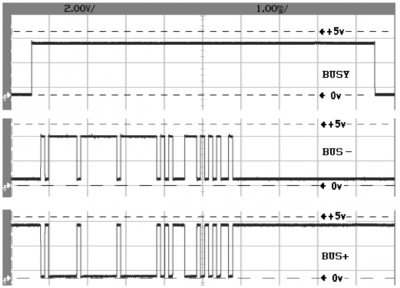SB9600: Difference between revisions
From W3AXL Wiki
Jump to navigationJump to search
(Created page with "SB9600 is a Motorola proprietary TLL communications protocol. It uses a pair of inverted signal lines, BUS+ and BUS-, along with a BUSY (and complementary {{overline|BUSY}} si...") |
|||
| (One intermediate revision by the same user not shown) | |||
| Line 1: | Line 1: | ||
SB9600 is a Motorola proprietary TLL communications protocol. It uses a pair of inverted signal lines, BUS+ and BUS-, along with a BUSY (and complementary | SB9600 is a Motorola proprietary TLL communications protocol. It uses a pair of inverted signal lines, BUS+ and BUS-, along with a BUSY (and complementary /BUSY) signal, to communicate between various components inside a radio, or between a radio and its control head. | ||
= | Radios known to use SB9600 for control include: | ||
* [[MTS2000]] and [[MCS2000]] | |||
* [[Astro Spectra]] | |||
* All [[Astro25]] radios | |||
= Physical Layer = | |||
[[File:MAEPF-27781-O-SB9600-Timing-Chart.PNG|thumb|left|400px|SB9600 signal diagram from the [[XTL2500]] detailed service manual. Note that this diagram incorrectly shows the BUSY signal as active high. The original SB9600 specification document calls for BUSY to be active low and /BUSY (not present on the XTL2500) to be active high]] | |||
The physical layer of SB9600 consists of complementary data and control lines. BUS+ & BUS- are bidirectional data lines and are complements of each other. BUS+ is active low and is essentially a standard UART line. BUS- is simply the inverse of BUS+. BUSY & /BUSY are bidirectional control lines used to avoid data collision and ensure only one device on the SB9600 bus is transmitting data at any given time. | |||
{| class="wikitable" style="margin:auto" | |||
|+ SB9600 Signal Lines | |||
|- | |||
! Name !! Description !! Default State | |||
|- | |||
| BUS- || Bidirectional differential data bus, active high || Low (0V) | |||
|- | |||
| BUS+ || Bidirectional differential data bus, active low || High (5V) | |||
|- | |||
| /BUSY || Bidirectional busy indicator, active high. Used for collision avoidance. || Low (0V) | |||
|- | |||
| BUSY || Bidirectional busy indicator, active low. Used for collision avoidance || High (5V) | |||
|} | |||
Latest revision as of 18:12, 19 March 2023
SB9600 is a Motorola proprietary TLL communications protocol. It uses a pair of inverted signal lines, BUS+ and BUS-, along with a BUSY (and complementary /BUSY) signal, to communicate between various components inside a radio, or between a radio and its control head.
Radios known to use SB9600 for control include:
- MTS2000 and MCS2000
- Astro Spectra
- All Astro25 radios
Physical Layer

The physical layer of SB9600 consists of complementary data and control lines. BUS+ & BUS- are bidirectional data lines and are complements of each other. BUS+ is active low and is essentially a standard UART line. BUS- is simply the inverse of BUS+. BUSY & /BUSY are bidirectional control lines used to avoid data collision and ensure only one device on the SB9600 bus is transmitting data at any given time.
| Name | Description | Default State |
|---|---|---|
| BUS- | Bidirectional differential data bus, active high | Low (0V) |
| BUS+ | Bidirectional differential data bus, active low | High (5V) |
| /BUSY | Bidirectional busy indicator, active high. Used for collision avoidance. | Low (0V) |
| BUSY | Bidirectional busy indicator, active low. Used for collision avoidance | High (5V) |